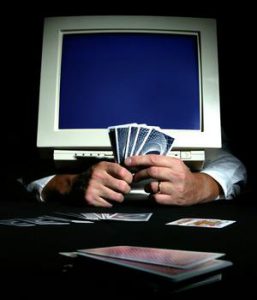Playing poker online bears many similarities to playing in a home-game or in a brick and mortar casino. After all, you’re still playing the same game, with the same rules, hoping to end your session with a profit. However, there are a couple of differences in terms of online poker strategy that should not be underestimated.
The most obvious disparity is the lack of any kind of visual ‘tells’ from your opponents that you can base your decisions on. However, not being able to see the other players at the table doesn’t mean there aren’t any tells through which you can obtain information about their hands. One of these tells is the speed with which a player bets. A quick bet is usually a sign for a rather strong hand, while a delayed bet often indicates that the player is pretending to think about how to make the most of his ‘monster hand’. The use of ‘auto-play’ boxes, with which you can pre-select an action before it is your turn to act, can also tell you a lot about your opponent’s hand. If, for example, the big blind immediately checks his hand preflop, you can assume he already checked the ‘check/fold’ button, indicating he had no interest in calling any sort of raise with his weak hand. On the other hand, a player using the ‘raise any’ box seems to be very confident about the cards in his hand. Following what is going on in the chat box at your table can also give you a good idea about which player is currently on tilt and their emotional state in general.
A great advantage of playing poker online is the vast number of tables you can choose from, which means you can be very selective as to where you choose to play. Many players will automatically go for the tables with the largest average pots, thinking this is where they can make the most money, but that is seldom the case. Large average pots often indicate that many players stay in the pot until the showdown, meaning that bluffing will rarely be successful and more often than not, you will need the best hand to win the pot. A good average pot size would be around 8-10 x the big blind, so for a $0.10/$0.20 table, that would be around $2. Preferably, you’ll also want to have 1 or 2 loose players and 1 or 2 tight players at your table, giving you more options to mix up your playing style.
The speed of the game in online poker is something that players may need to get used to at first. While at a live casino table you may see around 20 hands an hour, at the virtual tables this number can easily surpass 100. The advantage of this is that you won’t get bored too quickly while waiting for a good hand to play and won’t be tempted to call with mediocre cards simply to get some action. The option to play at more than one table at a time amplifies this advantage even more, especially when playing tournaments and/or Sit & Go’s, where a tight hand-selection is the key to success. PokerStars is often cited as being the best room for multi-tabling, not only due to their huge selection of games, but also thanks to their superior software that allows you to play at as many tables at once as you can physically handle.
Here is an example of someone playing a whopping 51 tables at a time on PokerStars:
{youtube, _f5IUP-ELzA}
